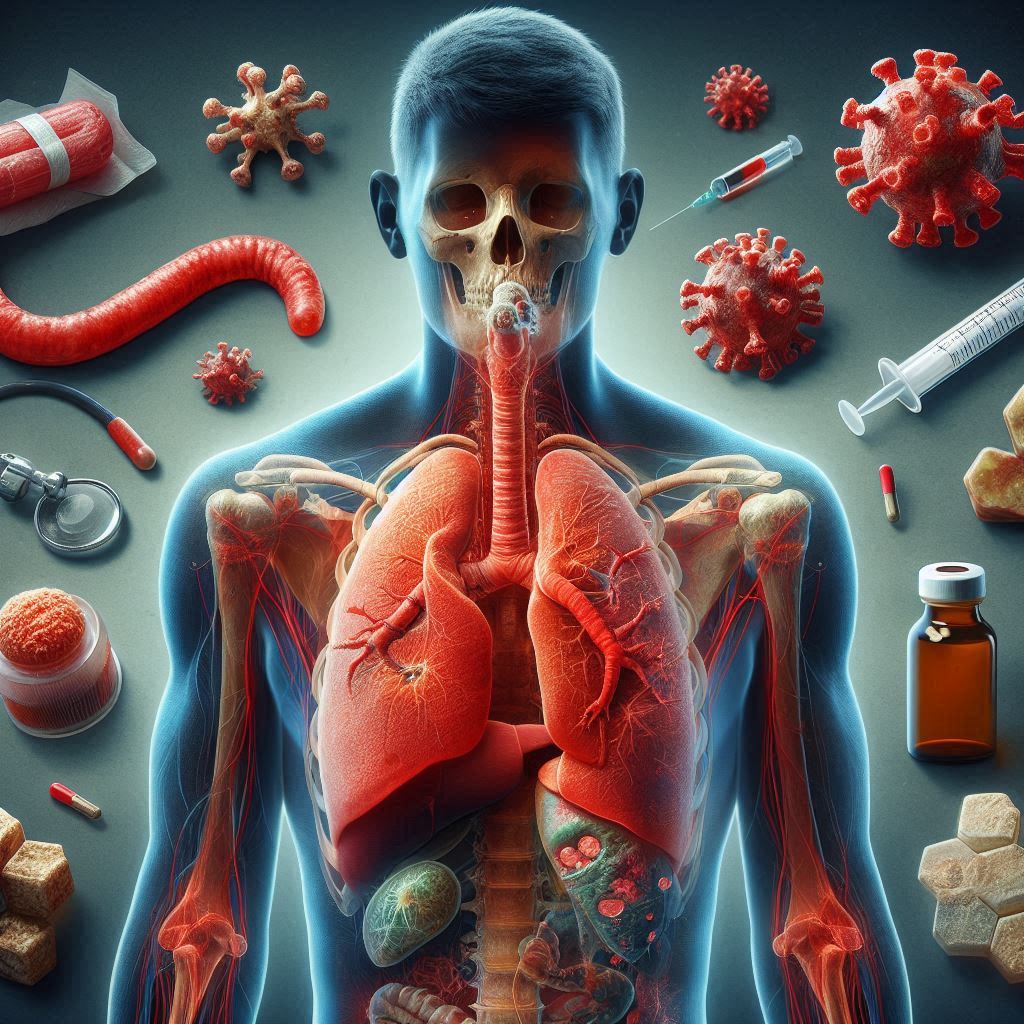Tuberculosis (Mycobacterium tuberculosis) Symptoms, Diagnosis, Herbal Treatment and Prevention
Tuberculosis (TB) is a serious infectious disease primarily affecting the lungs. TB is caused by the bacterium Mycobacterium tuberculosis. It was discovered on March 24, 1882, by Dr. Robert Koch identified as Mycobacterium tuberculosis, the bacterium responsible for TB. It spreads through the air when an infected person coughs, sneezes, or spits, releasing tiny droplets containing the TB germs. Tuberculosis generally affects the lungs, but it can also affect other parts of the body.
Types of Tuberculosis
Tuberculosis (TB) can be categorized into different types based on its characteristics:
- Active TB (TB Disease):
- Contagious and causes symptoms.
- Affects the lungs (known as pulmonary TB) or other body parts (extrapulmonary TB).
- Symptoms include unexplained weight loss, loss of appetite, fever, chills, fatigue, and night sweats.
- Requires prompt treatment to prevent complications.
- Latent TB Infection:
- TB bacteria are present in the body but remain inactive.
- No symptoms, and not contagious.
- Positive results in TB blood and skin tests.
- It can progress to active TB in some cases.
- Pulmonary TB:
- Active TB involves the lungs.
- Contracted by inhaling air exhaled by an infected person.
- Symptoms include persistent cough, coughing up blood, chest pain, and shortness of breath.
- Extrapulmonary TB:
- TB affects body parts outside the lungs (e.g., bones, organs).
- Symptoms vary based on the affected area:
- TB lymphadenitis: Swollen lymph nodes, fever, fatigue.
- Skeletal TB: Back pain, stiffness, bone deformities.
- Miliary TB: Spreads to multiple organs.
Remember, early diagnosis and proper treatment are crucial for managing TB effectively
Symptoms of Tuberculosis
Tuberculosis (TB) can manifest with various symptoms depending on the stage of infection:
- Primary TB Infection:
- Often asymptomatic.
- Some may experience flu-like symptoms:
- Low fever.
- Tiredness.
- Cough.
- Latent TB Infection:
- No symptoms.
- Immune cells wall off TB germs, preventing active disease.
- Active TB Disease (Lungs):
- Gradual onset of symptoms over weeks:
- Persistent cough.
- Coughing up blood or mucus.
- Chest pain.
- Pain with breathing or coughing.
- Fever, chills, and night sweats.
- Weight loss and fatigue.
- Gradual onset of symptoms over weeks:
- Active TB Outside the Lungs (Extrapulmonary):
- Symptoms vary based on the affected area:
- Fever, chills, night sweats.
- Weight loss, fatigue.
- Pain near the site of infection.
- Symptoms vary based on the affected area:
Remember, early diagnosis and treatment are crucial for managing TB effectively.
How Cigarette Causes Tuberculosis
Cigarette smoking plays a significant role in the development of tuberculosis (TB). Here’s how it happens:
- Immune Response: Tobacco smoke recruits specific immune cells into the lungs. Once there, these cells allow Mycobacterium tuberculosis (Mtb), the bacteria that causes TB, to proliferate.
- Ciliary Dysfunction: Cigarette smoke impairs cilia function, reducing the clearance of bacteria from the respiratory tract. This compromised defence mechanism makes the lungs more susceptible to TB infection.
Tuberculosis (TB) is caused by a bacterium called Mycobacterium tuberculosis. When a person breathes in TB germs, they can settle in the lungs and begin to grow. From there, the bacteria can spread through the blood to other parts of the body, such as the kidneys, spine, and brain
Remember, quitting smoking is essential for overall health and can help reduce the risk of TB and other respiratory diseases.
Mode of Tuberculosis Transmission
Tuberculosis (TB) spreads primarily through the air from person to person. Here’s how it happens:
- Transmission Route:
- TB germs are released into the air when someone with active TB disease coughs, speaks or sings.
- People nearby can inhale these tiny infectious droplets containing TB germs and become infected.
- Indoor vs. Outdoor:
- TB germs spread more easily indoors or in poorly ventilated areas.
- Crowded places increase the risk of transmission.
Treatment of Tuberculosis Disease
Tuberculosis (TB) treatment involves a combination of medications and care.
- Diagnosis:
- TB diagnosis includes various tests:
- Skin Test: Tuberculin is injected under the skin to check for immune system response. A positive test indicates latent TB or active TB disease.
- Blood Tests: These assess immune system recognition of TB. Positive results indicate latent or active TB.
- Chest X-ray: Detects irregular lung patches typical of active TB.
- Sputum Tests: Detect TB bacteria in mucus from coughing.
- Other Lab Tests: Breath tests, urine tests, and cerebrospinal fluid analysis.
- TB diagnosis includes various tests:
- Treatment Options:
- TB bacteria are cultured to determine the best treatment.
- A combination of medications is usually required for several months.
- Drug-resistant TB may need higher-order antibiotics or intravenous treatment.
- Multi-drug-resistant TB is more challenging to treat.
- Foods for TB:
- Eat calorie-dense, protein-rich foods.
- Consume vitamins A, E, C, B complex, selenium, and zinc.
- Avoid alcohol.
- Specialists:
- Consult a pulmonologist (respiratory system specialist) or an infectious disease specialist for TB management.
Remember, early diagnosis and adherence to treatment are crucial for successful TB management
Herbal Treatment of Tuberculosis
There are natural approaches that may complement medical care. Here are some herbal remedies and natural ways to support TB treatment:
- Adaptogenic Herbs:
- Rhodiola (Rhodiola rosea) and astragalus (Astragalus membranaceus) are adaptogens that help balance and protect the body’s immune system.
- Consider incorporating them into your routine.
- Garlic:
- Garlic has anti-inflammatory properties and may support immune health.
- You can consume fresh garlic or take garlic supplements.
- Other Herbs:
- Barberry, ginseng, horsetail, licorice, and green tea have potential benefits.
- Goldenrod, butcher’s broom, cayenne, and peppermint may also be helpful.
- Ayurvedic Herbs:
- Ayurvedic medicine suggests using herbs like vidarikand (Indian kudzu), brahmi (waterhyssop), rasonam (garlic), yashtimadhu (mulethi), ashwagandha (Indian ginseng), and guduchi (giloy).
Remember to consult with a healthcare professional before starting any herbal treatment, especially if you’re already on medication.
Preventive Measures for Tuberculosis
Preventing tuberculosis (TB) involves several strategies to reduce the risk of exposure and transmission:
- Early Diagnosis:
- TB testing identifies latent TB, allowing prompt treatment.
- Healthcare workers and those at higher risk should get tested.
- Workplace Prevention:
- Certain jobs (e.g., healthcare) increase exposure risk.
- Implement infection control measures in workplaces.
- Physical Distancing:
- Individuals with active TB should avoid close contact to prevent transmission.
- Air Quality Measures:
- Good ventilation helps disperse TB germs.
- Natural light (UV) can kill TB bacteria.
Remember, early intervention and hygiene play a crucial role in TB prevention.
International organizations and bodies that create awareness and treatment for tuberculosis
Several international organizations and bodies work tirelessly to raise awareness about tuberculosis (TB) and provide treatment. Here are some notable ones:
- World Health Organization (WHO):
- The WHO’s Global Tuberculosis Programme aims for a world free of TB, with zero deaths and suffering due to the disease.
- Their mission includes universal access to people-centred prevention and care, multisectoral action, and innovation.
- WHO develops guidelines and operational handbooks to accelerate increased treatment coverage in countries. They also support TB prevention through infection control measures and early screening.
- UNITAID:
- UNITAID collaborates with WHO and other partners to enhance access to shorter TB preventive treatment regimens.
- National Health Systems:
- Many countries have their own health systems that focus on TB prevention, diagnosis, and treatment.
- These systems work in collaboration with international organizations to combat TB.
Remember, these efforts collectively contribute to preventing and treating TB worldwide.
External links
Causes of tuberculosis
International organizations and bodies that create awareness and treatment for tuberculosis
Preventive measures for tuberculosis

